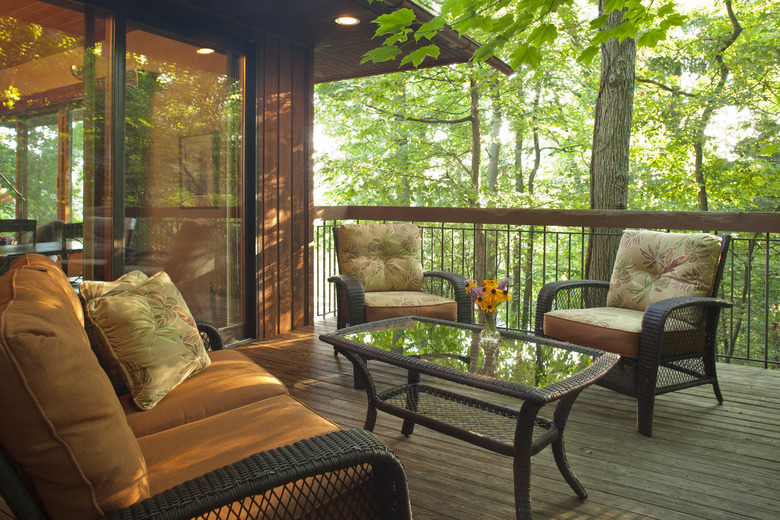How To Clean Mildew Off Of Outdoor Cushions
Mildew doesn't play favorites. Both indoor and outdoor sofa cushions may develop mildew spots and musty odors if the cushions stay damp or are stored in dark, dank conditions. But your patio furniture cushions are more likely to start growing spots of mildew since they're exposed to all sorts of weather. Moisture makes the mildew problem worse, so drying out your cushions and then keeping them as dry as possible helps eradicate mildew, mold and mustiness.
Dry Out the Cushions
Dry Out the Cushions
Air out cushions with mildew during dry conditions on a windy day to get rid of the dampness that causes mildew. Set each cushion someplace where air hits as much of the surface as possible, including the bottom and back. For example, lean them up against a railing or place them atop a plant stand outdoors. Rotate the cushions every few hours to expose other areas to maximum airflow. Sunshine helps dry out lawn chair cushions even more. Since the cushion is designed for outdoor use, it should be relatively resistant to fading. Unless the cushion is completely dry, cleaning it may just result in more mildew growth. Airing it out until it's dry also helps remove the musty odor that goes along with mildew. Use a scrub brush to brush away loose mildew while you're outdoors. To spot the mildew, check for small specks that look a bit like dirt.
Cleaning Outdoor Cushions With Vinegar
Cleaning Outdoor Cushions With Vinegar
White vinegar makes mildew vanish while helping remove musty odors trapped within the cushions. Spray full-strength vinegar over the mildewed cushion surface while you air out the cushion outdoors. Dip a scrub brush or toothbrush into a bit of vinegar to scrub the spots away. For stubborn mildew spots, soak a folded paper towel in white vinegar, and then set the wet towel directly over the mildewed area. Remove the paper towel and wipe with a damp sponge after 15 or 20 minutes. Wipe the area dry with another paper towel, and air-dry the cushion outdoors on a non-humid day.
Use Citrus and Salt
Use Citrus and Salt
Lemon juice and salt team up to serve as a natural mildew-busting paste safe for cleaning outdoor cushions. Make a paste out of lemon juice and water, and apply the paste directly to mildewed areas of the cushion, rubbing it in a bit with a soft-bristled brush such as a toothbrush. Allow the paste to dry in place on a sunny day. Wipe it away with a damp sponge. Another way to make the paste is to use a lemon rind with a bit of pulp and juice left inside. Sprinkle salt liberally over the inside of the lemon and rub the salted area over the mildew.
Bleach It Out
Bleach It Out
You can use bleach to remove stubborn mildew from an outdoor cushion. Put on a pair of rubber gloves to protect your hands. Mix 2 tablespoons of bleach into a quart of warm water. Dip a rag or scrub brush into the bleach water, and soak a color-fast cushion's surface with the solution for 15 or 20 minutes. Wipe the cushion down with a damp rag afterward to remove the bleach water. Air dry it on a sunny day. Test the cushion if you're unsure about its colorfastness by applying a few drops of the bleach water to an inconspicuous area and waiting 15 minutes. If your cushions lose color with regular bleach, try oxygen bleach.
Removing mildew on outdoor furniture cushions doesn't have to be difficult. Many items you have around your house right now can help get rid of the spots and leave your cushions looking like new.
